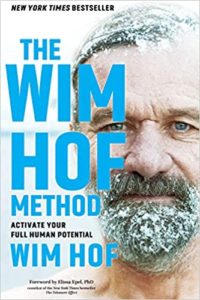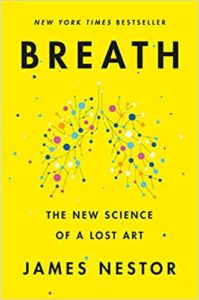My Experience with the Wim Hof Method
Dec 08, 2020
I hate being cold! And I get anxious when holding my breath. So, naturally, I chose to take up a daily practice that includes both of these things, right? But of course . . . I embrace challenges. I don't like that I have fear and apprehension about the cold and breath holding. When I learned that the Wim Hof Method (WHM) combines these things, I was intrigued and compelled to find out more. I thought, perhaps the WHM could help me create a new, more positive relationship with these things? Spoiler alert: it did!
Besides my curiosity about the WHM, I was also drawn to it as a potential path to better health. Since I was diagnosed with breast cancer over two years ago, my approach to recovery and avoiding future recurrence has been to boost my body’s organic disease-fighting capabilities. This includes maximizing my immune system so that my body is strong and can keep me healthy.
 In order to optimize my body’s internal chemistry, under the advice of a MD, I have been taking two handfuls of supplements every day. However, I detest doing this. Prior to my cancer, I rarely took a single pill—ever. Although I prefer taking these pills instead of prescription medications, it still doesn’t seem right to me. Author Wim Hof concurs. In his book, The Wim Hof Method, which was just released in October 2020, there is a story about a woman going through chemotherapy for breast cancer. After one week of doing the WHM, she tripled her white blood cells (cells of the immune system). Of course, you need to take this kind of anecdotal evidence with a bit of skepticism. But, maybe it is true. What’s the harm in trying a method that is completely natural, available to all of us, and free to try?
In order to optimize my body’s internal chemistry, under the advice of a MD, I have been taking two handfuls of supplements every day. However, I detest doing this. Prior to my cancer, I rarely took a single pill—ever. Although I prefer taking these pills instead of prescription medications, it still doesn’t seem right to me. Author Wim Hof concurs. In his book, The Wim Hof Method, which was just released in October 2020, there is a story about a woman going through chemotherapy for breast cancer. After one week of doing the WHM, she tripled her white blood cells (cells of the immune system). Of course, you need to take this kind of anecdotal evidence with a bit of skepticism. But, maybe it is true. What’s the harm in trying a method that is completely natural, available to all of us, and free to try?
Benefits of the Wim Hof Method
In addition to improving the immune system, the WHM offers many other rewards. The Wim Hof Method website lists the following general benefits, plus many more.
- Increased energy
- Better sleep
- Reduced stress levels
- Heightened focus & determination
- Increased willpower
Further benefits relevant to pain relief and performance include:
- Arthritis relief—You can have relief from both osteoarthritis and Rheumatoid arthritis by reducing inflammation through consciously controlling the autonomic nervous system.
- Fibromyalgia Relief—People who suffer from this ailment have fewer symptoms and better sleep, stress management, energy, mood and breathing patterns with the WHM.
- Elevated Sports Performance—Many experience faster recovery, enhanced focus and greater cardiovascular health and muscular endurance.
- Migraine Relief—The WHM has been found to relieve symptoms and reduce migraine frequency.
- Increased Mind-Body Connection—I believe that this is necessary to heal. It enhances awareness of what is happening inside your body as you move. You also gain perspective on how you mentally and emotionally respond to your pain.
Scientific Support
When you see this partial list of the WHM benefits, you might think that it is too good to be true. I agree. Can such simple things (breathing and cold therapy) produce these notable results? It seems unlikely.
 On top of that, many of us picture Wim Hof as “the Iceman.” Media coverage might have given you the impression of him as some crazy fool who does incredible stunts and sets world records for exercising in extreme temperatures.
On top of that, many of us picture Wim Hof as “the Iceman.” Media coverage might have given you the impression of him as some crazy fool who does incredible stunts and sets world records for exercising in extreme temperatures.
 I, and maybe you, too, are not alone in our uncertainty to accept these claims. Investigative journalist Scott Carney was also skeptical. So, Carney traveled to Poland to write an article on Wim Hof that would expose him as a fake. However, instead of exposing Hof, Carney actually became a convert! He consequently wrote about his experience in What Doesn't Kill Us. This book was one of my first introductions to the WHM.
I, and maybe you, too, are not alone in our uncertainty to accept these claims. Investigative journalist Scott Carney was also skeptical. So, Carney traveled to Poland to write an article on Wim Hof that would expose him as a fake. However, instead of exposing Hof, Carney actually became a convert! He consequently wrote about his experience in What Doesn't Kill Us. This book was one of my first introductions to the WHM.
In order to prove the critics wrong, Wim Hof seeks out and welcomes the study of his method. He is on a mission to expand this science and share it with the world. As a result, a body of research is amassing and continues to grow that backs up the claims. In his New York Times Best Selling book, Breath, James Nestor talks highly of the WHM and the supporting science. As an exercise scientist, I appreciated the studies behind the WHM. As a skeptic, however, I still needed to prove it to myself.
The Three Pillars of the Wim Hof Method
- Breathing
- Cold Therapy
- Mind/Commitment
Breathing
The WHM breathing creates a low-level stress in the body. This type of stress, called “hormetic stress,” actually benefits the body. It can make us stronger and healthier. Obviously, not all stress is bad! We need stress to live. Many of us just have too much of it. In contrast, the breath holds of the WHM breathing cycle induce relaxation. Here’s how it works.
First, you start the round of breathing with rapid, deep breaths. This breathing style is similar to the ancient inner heat practice from Tibet, Tummo. Breathing this way stimulates the sympathetic nervous system. In other words, the stress response. After you complete this high-intensity breathing, you conduct a breath hold. This now flips the switch on your nervous system to the parasympathetic nervous system, or, in other words, the relaxation response. You finish each round of breathing with a shorter recovery breath hold. Finally, you re-start the rapid breaths.
Hof describes his breathing style as meditation, and it definitely can be with practice. I have been experimenting with several types of breathing and meditation for over two years. Like many, I struggle calming my mind and not being distracted by my thoughts. With the WHM, I experience deep relaxation and have greater ease in clearing my mind. I feel the “charge,” as Hof calls it, in my body as my limbs tingle gently from the exertion. The relaxation I feel during the breath holds actually makes me look forward to that part of the breathing practice. That’s definitely a new and better relationship with breath holding!
After I complete the breathing cycle, I can hold my breath longer. This is because my oxygen levels rise during the cycle. And, my “breath hold” time is slowly improving. In order to do this, I use the WHM app to guide my practice. As a result, today I received the third breathing badge, which marks 50 sessions! I’ve also surpassed 200 rounds of the breath work. Whew!
Related Blogs
Start Meditating to Reduce Stress: 3 Easy Practices
5 Lessons from the Mindfulness-Based Stress Reduction (MBSR) Course
Human Being vs Human Doing
Overcoming Stress by Invoking the Relaxation Response
Book Review: Why Zebras Don’t Get Ulcers
Alkalizing the Body
The WHM claims that the breathing practice alkalizes the body. The claim is that your biochemistry changes after only 20 minutes of breathing. To be honest, I didn’t believe this at first. So, when I heard about it while I was doing the online Fundamentals Course, I decided to put it to the test, using the PH strips as the course instructs.
Here’s the process. You have to pee on the strip. Then, in just a few seconds, it records your PH. This is actually something I have been paying attention to since my cancer diagnosis. While going through treatment, I learned that most of us are too acidic. As a result, I have been drinking lots of lemon water, sometimes with baking soda, to alkalize my body. I also drink alkaline water. Despite this, I have had a hard time obtaining alkalinity. Thus, you see why I would doubt that a few breaths would change this for me.
However, I was wrong! It worked! Since I’ve started the breathing practice, I have tested my PH several times. The result? Each time, as long as I did at least four rounds of breathing—I tried to shortcut the process to see how little I could do and get the benefit—my system became alkaline. Additionally, I tested my PH directly before and after the breathing practice. The strip went from yellow/orange, which indicated an acidic state, to green/blue, which meant an alkaline state. And it did this every time! I was shocked. And clearly, I am shocked each time. Now I am trying to determine how long the effect lasts as well as the impact of what I eat and drink on my PH.
Hof likes to say: “You are the Alchemist.” You can change your biochemistry. And he’s right!
Cold Therapy
Similar to the breathing, going into the cold is a form of stress. When we repeat exposure to the cold, we build our ability to deal with adversity. As Hof points out, when you are in survival mode in the cold, you are most likely not thinking about your mundane concerns that can consume your inner dialogue. The cold can be a gateway to presence. You can be fully alive in the current moment.
The WHM uses cold showers and ice baths. This includes putting your hands and feet in a bowl of ice water as pictured at the top of this blog. On the showers, Hof advises you to start with a hot/warm shower and then end with the cold. The process is gradual. In order for it to work well, you should slowly increase your time in the cold. Actually, this is the only way I could have done it. Although it is harder on some days than others, it always feels good when I’m done. It is so refreshing and invigorating. Because I have taken an easy, measured approach, I have not had any problem remaining cold following the shower. However, it is probably good that I started in the summer when it was over 100 degrees Fahrenheit!
Although I have heard about the positive effects of cold showers before and tried it briefly, I didn't follow through consistently until I committed to the WHM. I recently finished the beginner level 20 day cold shower challenge! Now, I plan to start the intermediate level challenge later this month. We’ll see if I can work my way up to an ice bath or dip in a cold lake.
Why does this work? Let me explain. Cold exposure benefits our vascular system, all sixty-two thousand miles of it. Our vascular system regulates our body temperature by opening and closing our vessels (veins, arteries, capillaries) as required in response to the environment. If we never experience temperature extremes, the muscles that control these actions become deconditioned. Thus, a daily cold shower helps us regain this strength. So, are you convinced yet?
Mind/Commitment
 This is my favorite part of the method. After my final round of breathing, which is usually four rounds, I am very relaxed. I am calm, and I feel like I can sense the flow within my body. I stay present with this sensation and gently breathe. Sometimes I’ll do some breath counting, but generally I just try to be in this peaceful moment. Before I open my eyes, I set an intention for the day. Then I am off to the cold shower, my least favorite part of the method, even though the results are wonderful and my tolerance is growing.
This is my favorite part of the method. After my final round of breathing, which is usually four rounds, I am very relaxed. I am calm, and I feel like I can sense the flow within my body. I stay present with this sensation and gently breathe. Sometimes I’ll do some breath counting, but generally I just try to be in this peaceful moment. Before I open my eyes, I set an intention for the day. Then I am off to the cold shower, my least favorite part of the method, even though the results are wonderful and my tolerance is growing.
Hof refers to this third pillar of the WHM as “commitment.” To elaborate, in order for the WHM to succeed, you need to have the proper mindset and willingness to go outside your comfort zone. You need to dedicate yourself to conduct the breathing practice and (especially) the cold showers everyday.
Back in July, I started the Fundamentals course, but I didn’t finish. I only got halfway through it. Why? Because I didn’t fully commit. Instead, I allowed life circumstances to overtake my practice. After much inconsistency over the late summer and early fall, though, I have re-committed to the WHM. Throughout the past month, I have been doing the breathing and taking a cold shower at least five days a week. I’ve also been tracking my progress on the app. Feeling good is my reward, which keeps me motivated to continue.
So, how will I continue this progress? Well, I plan to re-start the Fundamentals course in the new year. Care to join me? If my experience has piqued your interest, you can learn more on the Wim Hof Method website. I recommend starting with the free mini class. If you do it, let me know! I’d love to hear about your experience. Or, if you’re already doing the WHM and have any suggestions or words of encouragement, I’d welcome that, too!
Stay connected with news and updates!
Join our mailing list to receive the latest news and updates from me.
Don't worry, your information will not be shared.
We hate SPAM. We will never sell your information, for any reason.

